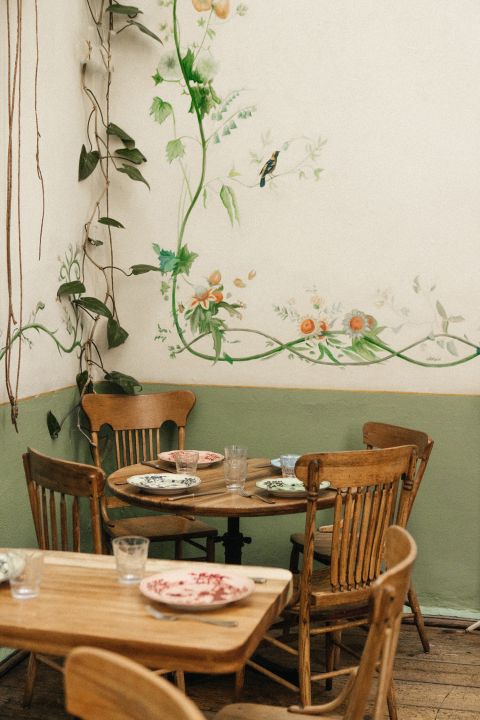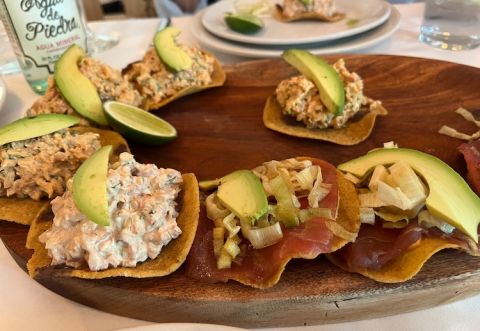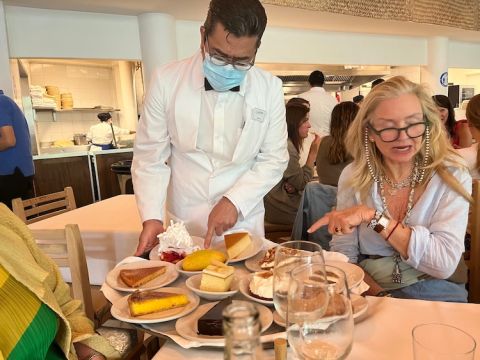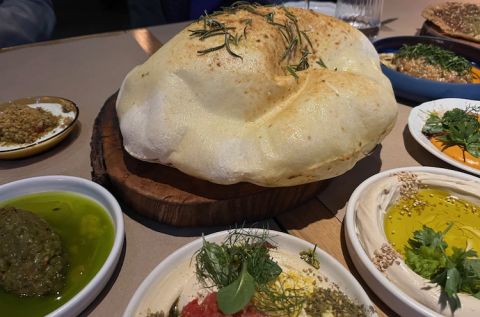No apologies for supplementing last week's article on eating out in Mexico City; it's currently a restaurant hotspot. Three more fine restaurants reviewed below, this time with women at the helm. Above, a glimpse into the kitchen at Rosetta, with chef Elena Reygadas second from the right.
The organisation behind the now-banal annual list of the World’s 50 Best Restaurants also makes a far more worthwhile award, to the World’s Best Female Chef of the year. Given the many years of misogyny that was rife in the restaurant industry, this award should receive far more attention than it does. I still remember an era when it was considered impossible for women to make it to the top of the profession because they were thought not strong enough to lift the heavy stock pots!
This year the winner is Elena Reygadas, chef and creator of Rosetta restaurant in Mexico City, pictured above with some of her team in the kitchen. This was announced only a few days before we ate and drank there extremely well last week.
Reygadas has worked extremely hard in her profession, having cooked for four years at Locanda Locatelli in London before opening Rosetta in 2010. The award comes as she presides over a growing empire: COVID-19 forced her to build out from the atmospheric house that is Rosetta’s home to situate a long line of tables and chairs on the pavement. On the ground floor is a small shop that sells traditional Mexican linens, crockery and glassware, mostly from Oaxaca, and close by there are a couple of her panaderias, her shops selling bread and coffee.
But the most impressive of all her numerous achievements is the creation of her restaurant in the most unlikely of settings. The building, and in fact, the whole of the Colonia Roma district in which it is located, was considered one of Mexico City’s most prestigious locations when it was built in the 1930s. But then from the 1970s in particular the whole neighbourhood suffered neglect. Enter Reygadas and numerous other restaurateurs, artists, designers and booksellers so that today this neighbourhood is considered one of the city’s most glamorous and sought after.
To have seen the potential of this building must mean her eye is as good as her cooking because I spent the first 10 minutes walking around trying to work out where all the essential ingredients of a restaurant were located. The elegant main dining room is on the ground floor, its double-height walls adorned with plants and leafy murals. From it a staircase leads up to a quirky bar, flanked by two private dining areas. Beyond the one on the left is the kitchen which unites with the customers downstairs via another staircase – not the easiest of arrangements. Lavatories are located in the basement; tall customers, watch your head!
The menu is predominantly Italian but with a heavy nod to Mexico and Mexican ingredients, both of which Reygadas acknowledges in her massive cookbook Rosetta, complete with a map of Mexico which shows the sources of the produce she and her kitchen work with. There is also a photo of the personnel in her kitchen which shows the female contingent far outnumbering the male. Mexican cooking, like so many others, has its roots firmly in the domestic kitchen despite the increasing refinement over the past 50 years.
Rosetta’s menu was to my eyes a mixture of the familiar and unfamiliar. There was a minestrone, a risotto and several pasta dishes alongside a dish of green tomatoes, sweet-potato tamales and black cod. We began with the thick and succulent tamales before progressing to an absolutely delicious Italian dish given a Mexican twist: four round ravioli stuffed with ricotta, all of it heavily laced with lemon.
My main course was a fillet of snook topped with finely diced, deftly seasoned celeriac. But it was two desserts that were to steal the show, described on the menu as ‘hoja santa y cacao criollo blanco’ and ‘mamey, pixtle y taxcalate’. The first was kindly translated for us as ‘Mexican pepper leaf with native white chocolate’ but the second our waitress found impossible to translate. The first arrived with a deliciously fragrant large green crystallised leaf on top of a featherlight white chocolate mousse (chewing the leaf gave me a very short-lived high). The second comprised slices of sapote fruit on top of a white mousse with a firm biscuit underneath. It was terrific and, because it was the first time we had tasted sapote, it was an exciting experience as well.
I would not hesitate in comparing Elena Reygadas to Sally Clarke. Both have evolved their particular style of cooking firmly rooted in the best seasonal produce. But both chefs have also appreciated the importance of making their customers feel comfortable; of allowing them to be excited visually while they are sitting in their restaurant; and of making them eager to return as soon as they have left. Both establishments, incidentally, somehow look verdant.
A fishy business
In 1998 another Mexican female chef, Gabriela Cámara, then just 21, opened Contramar, a restaurant that has been exciting visitors ever since. It had been recommended to us by both Gary Boom, founder of Bordeaux Index, and Nick Bramham, chef at Quality Wines.
Walking into this restaurant on a sunny lunchtime is a treat. The tables are bare, simply covered in a white linen tablecloth that contrasts with the pale white wooden chairs. Across the entire right-hand wall is a blue-and-white drawing of fish bones, nine in total, of varying sizes. And across the ceiling and on top of the open kitchen Cámara has installed matting that goes some way to making the acoustics in the restaurant workable.
Contramar, which translates as ‘against the sea’, offers a simple menu designed to show off the finest fish. (It is said in Mexico that all the best fish is to be found in the capital.) There are many species of fish and shellfish and almost every style of preparation: fish soup, pasta with shrimps, salads, sushi and sashimi. Our table of four began with a dozen fish tostados, one each generously and sumptuously topped with the sweetest tuna, diced shrimps and diced octopus. We then ordered the grilled fish that was priced at 595 pesos for 500 grams and had the added advantage of being offered with two toppings, red and green, red chilli and parsley. This was a cabrilla, a type of grouper, that had been grilled and split open before being seasoned. It was succulent and did not last very long.
Bramham had also advised me that on his visit he had finished with the most magnificent mango. In the centre of the tray of desserts the waiter brought to our table – a clever and effective example of salesmanship – was a mango which the waiter told me was from Brazil and which I promptly ordered. It was sweet and juicy but not fantastic so I will have to return to Contramar when Mexican mangoes are in season. The fish cooking will, I am sure, be as excellent as it was the first time. My bill for four came to 3,700 pesos (£164) without service. (Service was never included in our Mexican restaurant bills.)
Another female chef to watch is Daiana Vinci, head chef at Mishiguene (pictured below), an outpost of the highly successful restaurant in Buenos Aires that takes its name from the Jewish word for crazy or eccentric, and describes itself as serving the ‘cooking of immigrants’.
Despite the fact that Mexico City has a considerably smaller Jewish population than Buenos Aires, this new restaurant occupies a large site dominated by an enormous open kitchen at its centre. It is not the place for an intimate, romantic diner à deux but rather for larger, more boisterous parties.
But the food it serves has made an impact, probably because it is unusual for CD MX, as the locals write it, and very well executed. We began with tahini, falafel and hummus and followed this with kibbe, baba ganoush and sautéed squid – shades of Ottolenghi but with spicier sauces – before all four of us shared an excellent baklava and – shades of Argentina – a dulce de leche ice cream. All this, as well as a bottle of Trimbach Pinot Blanc from Alsace, brought the bill to 5,000 pesos (£222) without service.
This plethora of talented female chefs in Mexico City is to be welcomed and enjoyed. With the news that Claudia Sheinbaum, the current mayor, is the favourite to become the country’s first female president when elections take place next year, this is a positive trend that is likely to gain even wider recognition.
Rosetta Colima 166, Colonia Roma Norte, 06700 Ciudad de México; tel: +52 (55) 5533 7804
Contramar Durango 200, Colonia Romas, Cuauhtémoc, 06700 Ciudad de México; tel: +52 (55) 5514 9217
Mishiguene Pedregal 24, Lomas, Torre Virreyes, 11040 Ciudad de México; tel: +52 (55) 9131 7226







